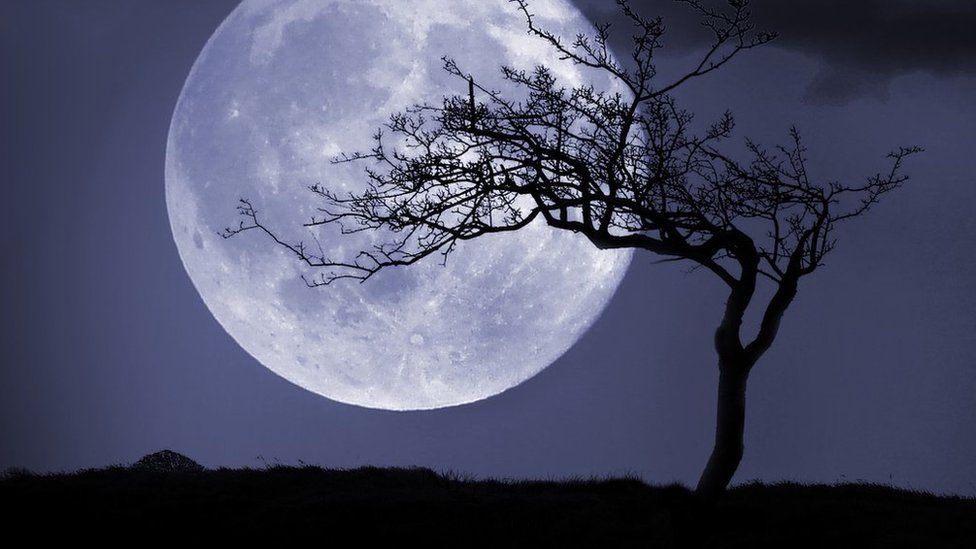Blue Moon 2023: What is it and when can you see the supermoon?
- Published

The full moon on 30 August will be a supermoon and a Blue Moon - blue by name and not by colour (in case you were wondering).
They normally occur every two or three years and are when two full moons appear in the same month.
We typically have 12 full moons each year, with each of these having their own name, such as Strawberry Moons, Harvest Moons or Worm Moons.
But Blue Moons are a bit different. The cycle of the Moon - the time it takes to go through its different phases - takes 29.5 days to complete.
This means that 12 full cycles take 354 days, which is less than the 365 days (or 366 days) in our calendar year.
This 13th full moon of the year does not fit with the normal naming scheme, so is instead referred to as a Blue Moon.
This has led to the phrase 'once in a Blue Moon', meaning something that doesn't happen very often.
What is the best way to see the Super Blue Moon?
Beginner's guide to astronomy
You will need a clear night, with little cloud coverage, away from buildings and street lights to give you the best view possible.
And although you do not need any special equipment to enjoy the night sky, a pair of binoculars will help you get an even better view.
Why do the monthly full moons have names?
BBC expert explains why we see the Moon differently throughout the year
Throughout history people have used the Moon, and the light it reflects, for different tasks - like hunting, planting and harvesting.
Cultures across the world give these full moons different names to fit with what was happening in the month. You can find out all their different names below.
The modern calendar doesn't quite follow the Moon's phases so sometimes there's more than one full moon a month. This is called a Blue Moon. Why not see if you can find your birthday month's moon below?
What are the names of the monthly full moons?
January: Wolf Moon
Native Americans and Medieval Europeans called this moon a Wolf Moon, it's thought to be because wolves howled more at this time of year as there was less food.
February: Snow Moon
The snowy weather of February in North America led to the name Snow Moon. Other common names include Storm Moon and Hunger Moon.
March: Worm Moon
The Worm Moon appears in March at the end of winter when little creatures like worms start squirming out of the ground. It's also called Milk Moon.
April: Pink Moon
Pink Moon was named after phlox flowers
Disappointingly the Pink Moon isn't actually pink. It's named by native Americans after pink flowers called wild ground phlox, which bloom in early spring and appear throughout the United States and Canada.
It is also called Egg Moon and Fish Moon in other cultures.
May: Flower Moon
In May 2021 the UK saw a rare super flower blood moon
May's spring flowers are the reason for this month's name.
Other names include the Hare Moon, the Corn Planting Moon, and the Milk Moon.
June: Strawberry Moon
Native American Algonquin tribes named this moon the Strawberry Moon. This is because they would harvest strawberries during this time.
It's also called the Honey Moon, Rose Moon and Mead Moon.
July: Buck Moon
The Buck moon is in July and is sometimes known as the thunder moon
This is the time when a buck, which is a male deer, grows its full antlers. This moon is also called Thunder Moon after the summer thunder storms.
August: Sturgeon Moon
Tribes in North America caught sturgeon, a type of fish, around this time.
It is sometimes called a Grain Moon.
September: Corn Moon
If it is the nearest full moon to the autumnal equinox it is called the Harvest Moon instead.
September's full moon is probably called Corn Moon because that's when crops are gathered at the end of the summer season.
At this time, the Moon appears particularly bright so farmers could continue harvesting into the night.
October: Hunter's Moon
This is the time when people would plan for the winter months and hunt animals for food.
Like September's moon it is sometimes called the Harvest Moon.
In 2020 October's first full moon was a Harvest Moon and the second a Blue Moon.
November: Beaver Moon
A full November Beaver Moon rising above the top of Glastonbury Tor
Beavers often start building their dams about this time which is where it got its name. It is sometimes called Frost Moon.
December: Cold Moon
The winter chill gave December's full moon the name Cold Moon. Other names include the Long Night Moon and the Oak Moon.
- Published27 April 2020
- Published30 August 2022
